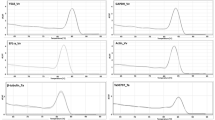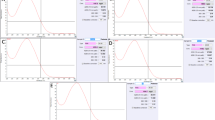Abstract
When conventional RNA isolation methods optimized for pine seedlings are applied to needles of adult pine trees, poor-quality RNA results. Here we describe a modified procedure to isolate high-quality RNA from needles of 30-year-old maritime pines, exhibiting high levels of phenolics, polysaccharides, and RNases. Major changes are the inclusion of proteinase K in the extraction medium followed by incubation at 42°C. Integrity and purity were evaluated by using denaturing gel electrophoresis and spectrophotometry (A260/A230 and A260/A280). The total RNA could be successfully used for poly(A)+-RNA isolation and cDNA library construction.
Similar content being viewed by others
Abbreviations
- CTAB:
-
hexadecyltrimethylammonium bromide
- DEPC:
-
diethyl pyrocarbonate
- FW:
-
fresh weight
References
Avila C and Cánovas FM (2000) An improved and rapid method for the isolation of poly(A)+-RNA from small samples of scot pine seedlings. Plant Mol Biol Rep 18: 117–122.
Chang S, Puryear J, and Cairney J (1993) Simple and efficient method for isolating RNA from pine trees. Plant Mol Biol Rep 11: 113–116.
Claros MG and Cánovas FM (1998) Rapid high quality RNA preparation from pine seedlings. Plant Mol Biol Rep 16: 9–18.
Green PJ (1994) The ribonucleases of higher plants. Annu Rev Plant Physiol 45: 421–445.
Logemann J, Schell J, and Willmitzer L (1987) Improved method for the isolation of RNA from plant tissues. Anal Biochem 163: 16–20.
Loomis WD (1974) Overcoming problems of phenolics and quinones in the isolation of plant enzymes and organelles. Meth Enzymol 31: 528–545.
López-Gómes R and Gómes-Lim MA (1992) A method for extracting intact RNA from fruits rich in polysaccharides using ripe mango mesocarp. HortScience 27: 440–442.
Wilkins TA and Smart LW (1996) Isolation of RNA from plant tissue. In: Krieg PA (ed), A laboratory guide to RNA: isolation, analysis and synthesis, pp. 21–42, Wiley-Liss, Inc, New York.
Xu N, Johns B, Pullman G, and Cairney J (1997) Rapid and reliable differential display from minute amounts of tissue: mass cloning and characterization of differentially expressed genes from loblolly pine embryos. Plant Mol Biol Rep 15: 377–391.
Author information
Authors and Affiliations
Rights and permissions
About this article
Cite this article
Azevedo, H., Lino-Neto, T. & Tavares, R.M. An improved method for high-quality RNA isolation from needles of adult maritime pine trees. Plant Mol Biol Rep 21, 333–338 (2003). https://doi.org/10.1007/BF02772582
Published:
Issue Date:
DOI: https://doi.org/10.1007/BF02772582




